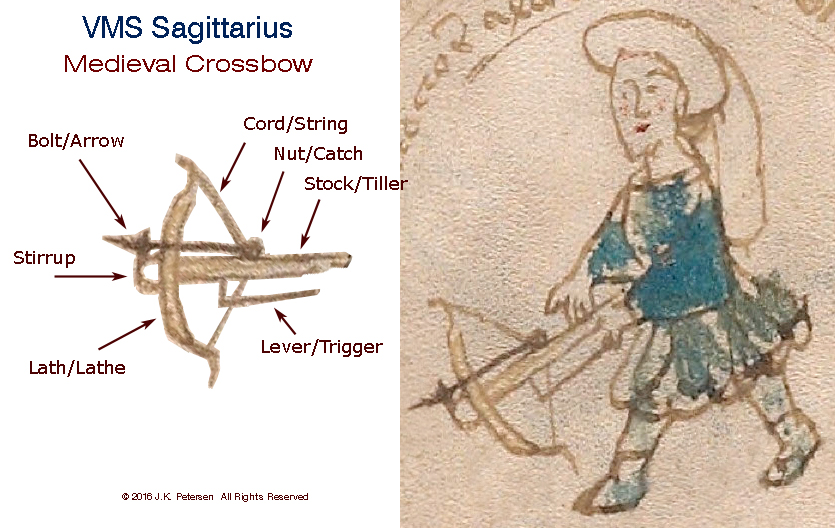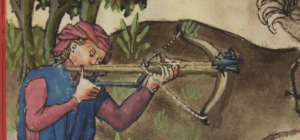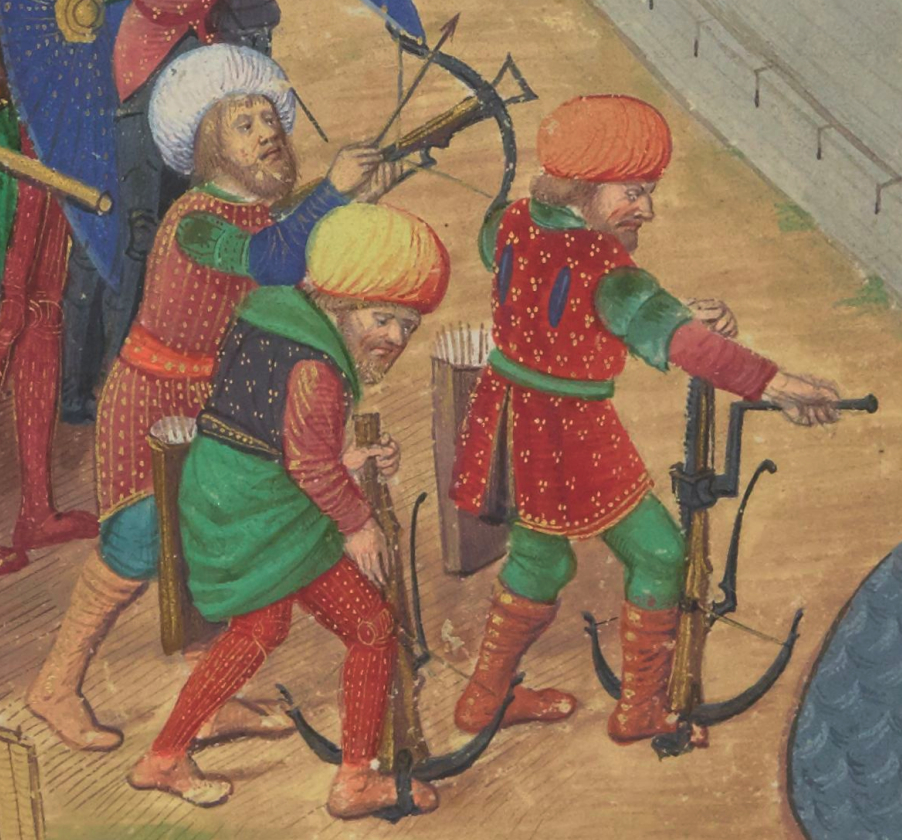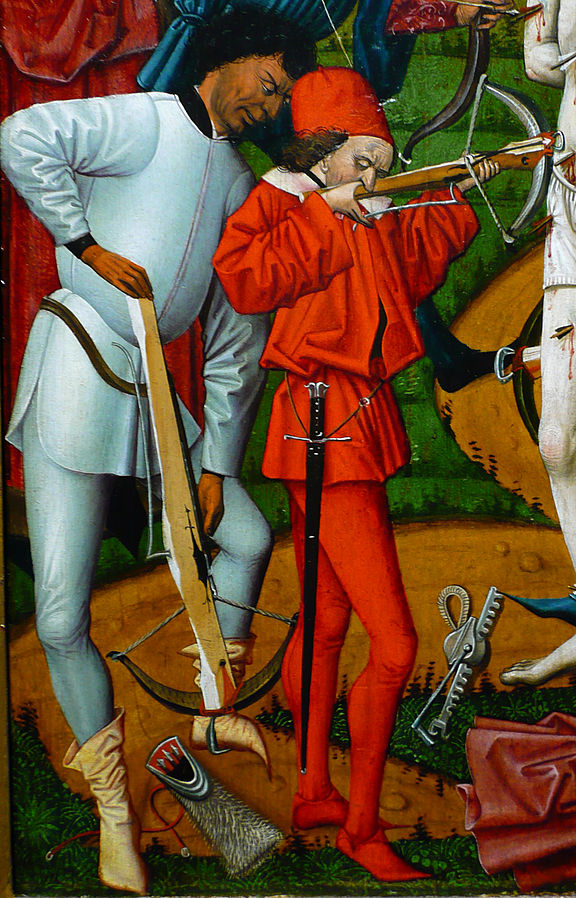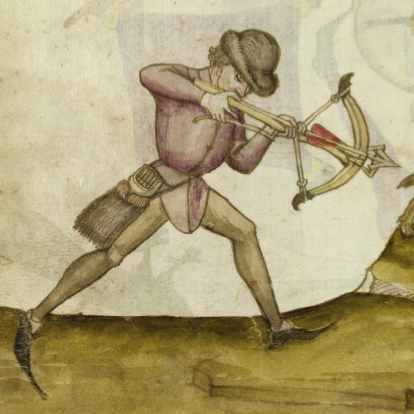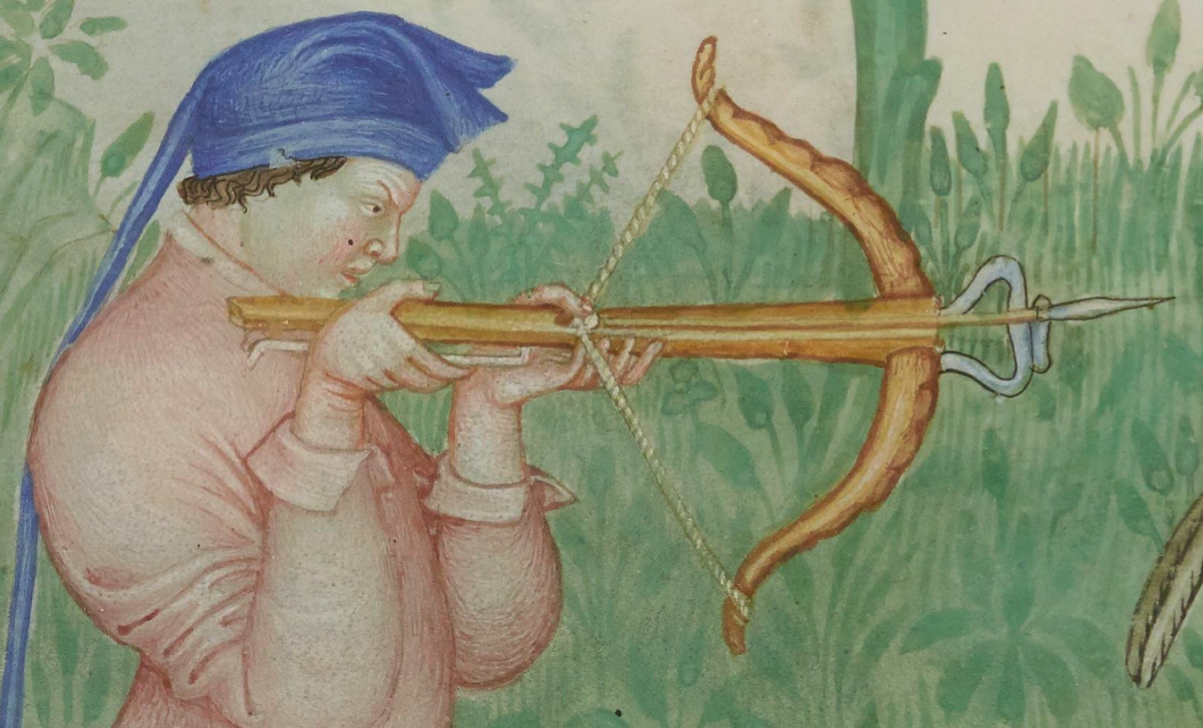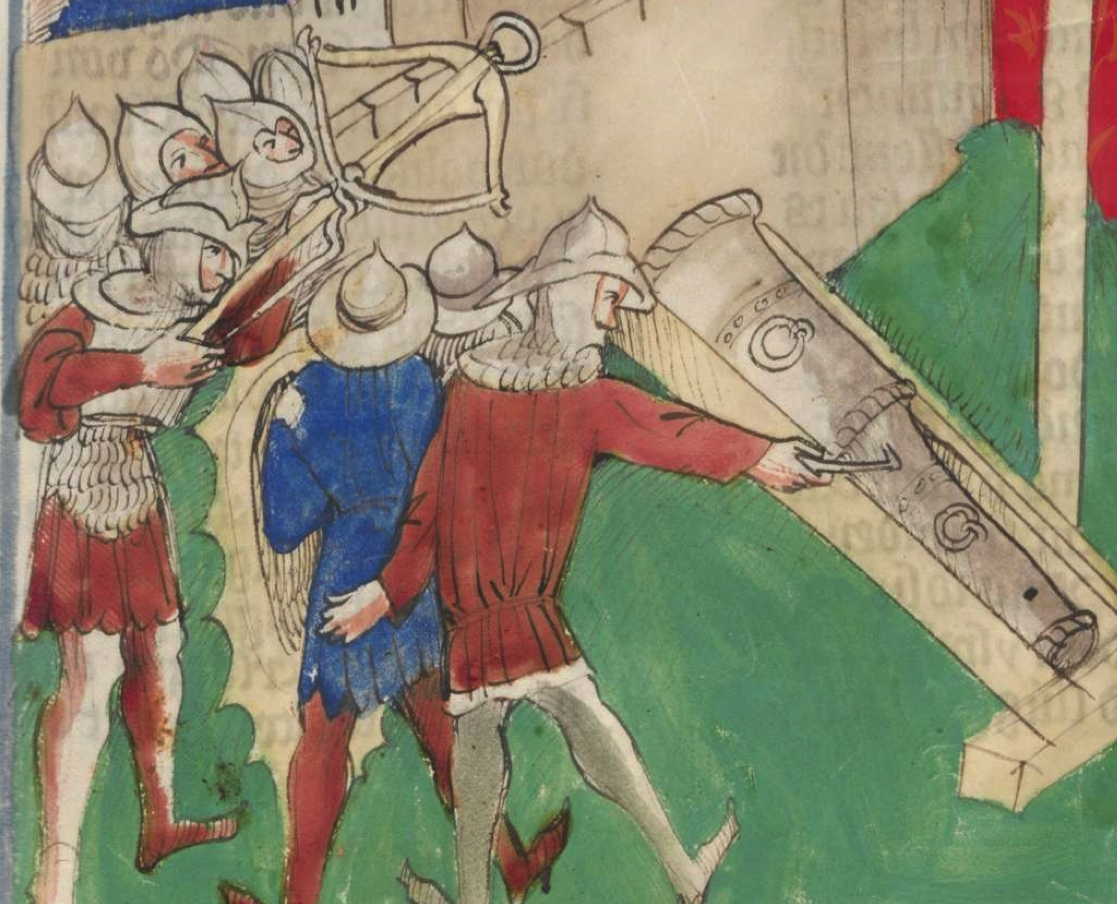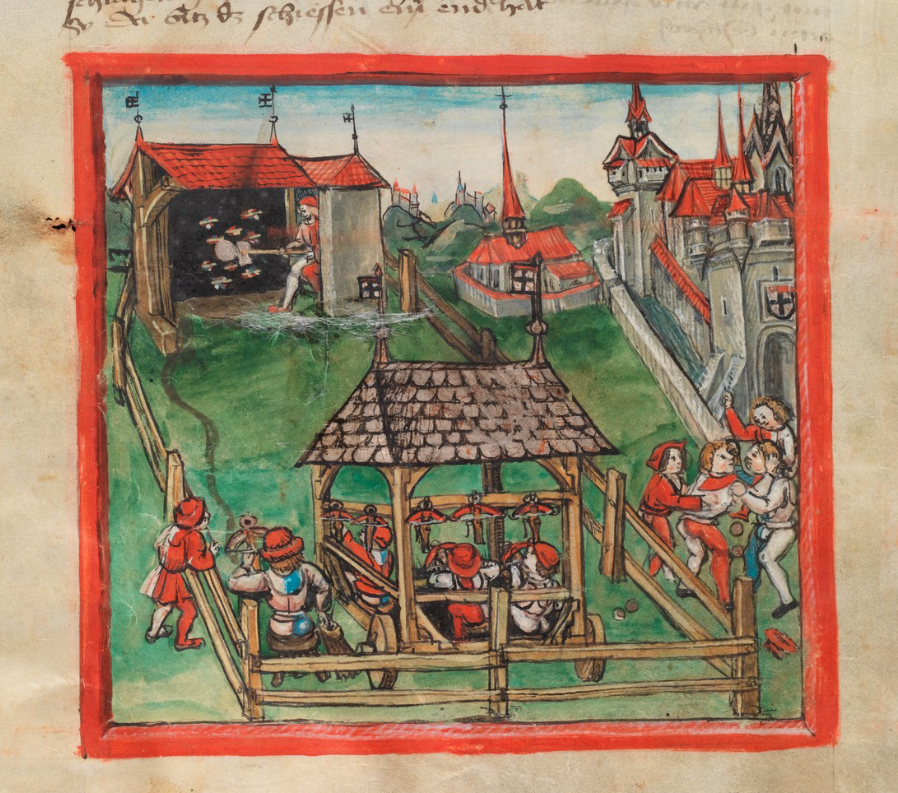The Bard with a Bow
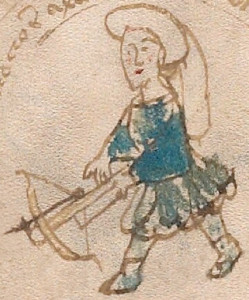 In the Voynich Manuscript, Sagittarius the archer has two legs and carries a crossbow. Most depictions of Sagittarius show a four-legged centaur with a longbow, so I searched for those that were similar to the VMS archer and described them in a previous post. This time, I’m more interested in the details of his dress and his bow. On the right, I’ve removed some of the text that was crowding the picture so you can see his crossbow and costume more clearly.
In the Voynich Manuscript, Sagittarius the archer has two legs and carries a crossbow. Most depictions of Sagittarius show a four-legged centaur with a longbow, so I searched for those that were similar to the VMS archer and described them in a previous post. This time, I’m more interested in the details of his dress and his bow. On the right, I’ve removed some of the text that was crowding the picture so you can see his crossbow and costume more clearly.
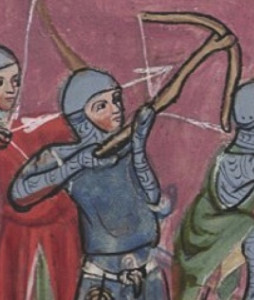 It’s unlikely the archer is dressed for warfare like the 14th century warriors pictured left. The long tail on his hat would be a distraction and a liability, but his dress is not uncommon for archers participating in crossbow tournaments or involved in recreational hunts.
It’s unlikely the archer is dressed for warfare like the 14th century warriors pictured left. The long tail on his hat would be a distraction and a liability, but his dress is not uncommon for archers participating in crossbow tournaments or involved in recreational hunts.
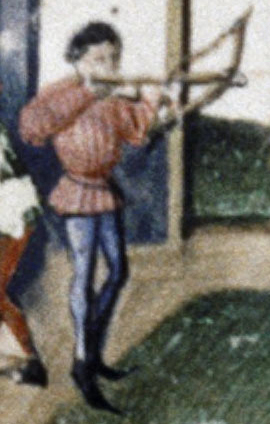 A pleated tunic is typical for the middle ages, as is the style of the VMS archer’s hat. The broad sleeves are not as common as narrow sleeves, but are not unusual either. On the right is an archer at an English crossbow tournament wearing a similar outfit sans hat.
A pleated tunic is typical for the middle ages, as is the style of the VMS archer’s hat. The broad sleeves are not as common as narrow sleeves, but are not unusual either. On the right is an archer at an English crossbow tournament wearing a similar outfit sans hat.
Hat tails made from fabric or sometimes from the tails of animals, like foxes, were common in many areas. The VMS archer also sports a goatee and booties and appears to be wearing leggings, as his legs are painted blue.
The Style of the Crossbow
Most zodiac drawings don’t have enough detail to determine the style of crossbow, but perhaps the VMS does.
To help identify the archer’s bow, I removed it from his hands and labeled the visible parts. Fortunately, the trigger was visible, along with the shape of the stirrup. The style of the lathe is fairly clear and shows recurved tips. The catch, an important component that holds the cord until it’s ready to fire, is barely shown, but it clearly doesn’t have the crank called a cranequin that is found on some of the later crossbows. The stock looks pretty basic—this is not one of the high-octane automatic crossbows from China nor does it resemble earlier Greek and Roman crossbows that lacked a stirrup.
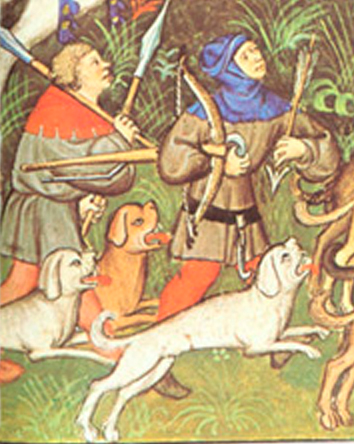
A hunting bow from a French manuscript from the mid- or late 1300s was drawn with a rounded stirrup, recurved lathe tips, and an angled lever. The bolt has a traditional arrowhead rather than a narrow spike.
Who Used this Style of Bow?
This simple style of crossbow isn’t difficult to find in medieval imagery—it can be seen in English, Czech, French, and Lombardic manuscripts from about the late 13th century to the mid-1400s. After that, some of the crossbows include accessories for drawing the cord and some have spikes on the stirrup, which I assume is to stabilize them in the soil when stepping on the stirrup.
I don’t have enough images to know if it’s a general pattern, but many of the images of battle bows had straight stirrups while some of the hunting bows, like the one on the right, had rounded stirrups. It’s not a hard-and-fast distinction, however.
An early Hussite bas relief also has a crossbow with a rounded stirrup, but the trigger is not shown and the lathe is not as broad as the one in the VMS, so it’s difficult to know if it’s the same kind.
Sometimes the bolts have narrow tips, sometimes the classic arrow shape. Crossbows in a c. 1380 manuscript from France are similar to the VMS, but the stirrup is quite thick and the trigger is not shown.
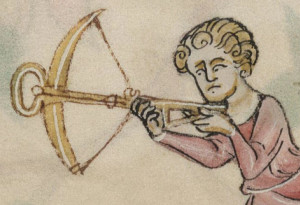 The image on the left is not a zodiac crossbow, it’s a marginal embellishment from an English psalter created around 1330, but it’s interesting because it shows the joint between the lathe and the stock more clearly than most (the illustrator has rotated the trigger, probably to make it easier to see). The stirrup is rounded, like the VMS, but the lathe has a narrower span and doesn’t have recurved tips.
The image on the left is not a zodiac crossbow, it’s a marginal embellishment from an English psalter created around 1330, but it’s interesting because it shows the joint between the lathe and the stock more clearly than most (the illustrator has rotated the trigger, probably to make it easier to see). The stirrup is rounded, like the VMS, but the lathe has a narrower span and doesn’t have recurved tips.
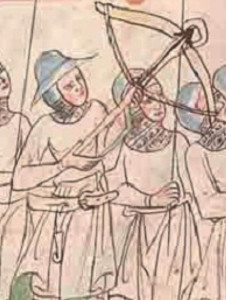 A number of the French manuscripts illustrate narrow bolts, probably developed because they could penetrate armor, while the one on the right, from the Czech region, shows arrow-shaped bolts. How accurately illustrators have represented the bolts (and the crossbows themselves) is hard to assess.
A number of the French manuscripts illustrate narrow bolts, probably developed because they could penetrate armor, while the one on the right, from the Czech region, shows arrow-shaped bolts. How accurately illustrators have represented the bolts (and the crossbows themselves) is hard to assess.
Quite a few crossbows from France, Switzerland, and the upper Rhine are depicted with a different style of stirrup that is flatter at the end and more angular than the rounded stirrup in the VMS.
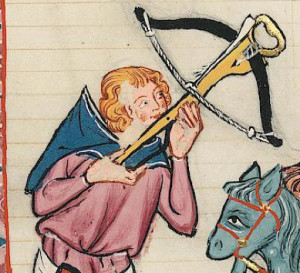 This flatter stirrup is illustrated in a Germanic image of a hunting bow from the early 1300s (right). The lathe has probably been rotated in the image to show it more clearly, as the triggers were usually on the bottom rather than on the side of the stock. The image is thought to depict a nobleman from eastern Lombardy. Note the recurved tips.
This flatter stirrup is illustrated in a Germanic image of a hunting bow from the early 1300s (right). The lathe has probably been rotated in the image to show it more clearly, as the triggers were usually on the bottom rather than on the side of the stock. The image is thought to depict a nobleman from eastern Lombardy. Note the recurved tips.
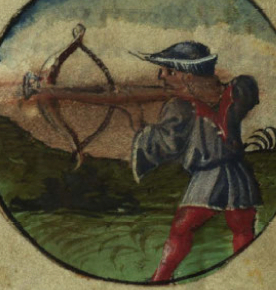 The symbol for Sagittarius on the left from c. 1469 was created in southern Germany or possibly eastern Austria and has recurved tips and a flattened stirrup similar to the previous non-zodiac image. Notice also the pleated tunic, wide sleeves, and typical leggings. The pointed hat is a different style from the VMS, but it’s one of the few examples of Sagittarius with a crossbow wearing a hat.
The symbol for Sagittarius on the left from c. 1469 was created in southern Germany or possibly eastern Austria and has recurved tips and a flattened stirrup similar to the previous non-zodiac image. Notice also the pleated tunic, wide sleeves, and typical leggings. The pointed hat is a different style from the VMS, but it’s one of the few examples of Sagittarius with a crossbow wearing a hat.
Summary
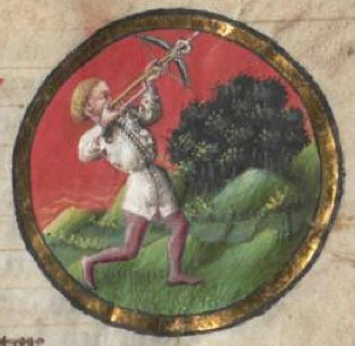 It’s difficult to find examples of Sagittarius with both legs and a crossbow but those identified so far are from central Europe. It’s even more difficult to narrow it down to crossbows with a curved stirrup, because the stirrup is usually not clearly drawn in medieval Sagittarius symbols. In fact, the crossbow in the VMS shows more details than most examples of Sagittarius with legs, with the exception of one from approximately the mid-1400s shown on the right.
It’s difficult to find examples of Sagittarius with both legs and a crossbow but those identified so far are from central Europe. It’s even more difficult to narrow it down to crossbows with a curved stirrup, because the stirrup is usually not clearly drawn in medieval Sagittarius symbols. In fact, the crossbow in the VMS shows more details than most examples of Sagittarius with legs, with the exception of one from approximately the mid-1400s shown on the right.
The VMS archer is also unusual in that he’s wearing a long-tail hat and a beard. The other zodiac symbols with crossbows and legs don’t include these features except for the one mentioned above. You have to look at images of crossbows that are not related to zodiacs to find them.
Did the VMS illustrator add the extra details based on seeing non-zodiac illustrations or based on personal observations? As with so many aspects of the VMS, there’s a level of uniqueness in the images that adds to the mystery.
J.K. Petersen
© Copyright 2015 J.K. Petersen, All Rights Reserved
Additional image added Oct. 27th, 2016:
Sometimes I come across a picture on the Web or in my files that relates to a previous blog that is worth including with the original material. I thought this image from BNF Lat. 9333, folio 68v, (created in the early 15th century) was particularly relevant. The book was inspired by an earlier copy of Tacuinum Sanitatus—a manuscript on living a healthful life.
The image is more detailed than the VMS crossbowman, including a loaded bolt, twirled cord, and lamination seam in the stock, but what caught my attention was the long trigger, and lath tips that are curved slightly more than those in many medieval crossbow drawings. I thought readers might enjoy seeing it.
Additional image added Nov. 11th, 2016:
Another interesting crossbow image in a siege commentary from BNF Latin 6067 (later 15th c) illustrating three archers. The first is loading a bolt, the second pulls the string while his foot supports the bow with the stirrup, and the third has a more automated form of crossbow with a crank to pull the string. The crank provides more leverage but also more weight and would be more appropriate for seige warfare than hunting. Quivers of bolts can be seen attached to belts. The two fully visible triggers are relatively long (the one on the right might be slightly stylized).
Additional image added July 7, 2017:
This image post-dates the VMS, but I felt it worth including because it illustrates a long-triggered crossbow drawn with considerable detail for the time. (The source is a c. 1475 painting of the martyrdom of St. Sebastian from a region of Munich, Germany, now in the Wallraf-Richartz-Museum, Cologne):
Additional image added August 7, 2017:
There is a clear drawing of a crossbow in Thott 290 2° (c. 1459). I was aware of it but didn’t include it in the original blog because it probably postdates the VMS. However, I’ve decided to add it because it has a long trigger and curved ends on the lath, similar to the VMS crossbow (note, however, that it has a straight stirrup), and because I noticed recently that it is similar to the crossbow and bolt in BNF Lat. 9333 noted above:
Additional image added October 16, 2108:
Close-up drawing from BNF NAL 1673 illustrating a narrow bolt, flat stirrup, the winding pattern of the cord, and a lath with a horn texture and extra curve at the tips. He’d better get his thumb off the nut before the trigger engages or he’ll shred then end of it:
Dec. 8, 2018 Additional Image (BSB CLM 74):
25 October 2019 Additional Image—a crossbow practice range on a movable pavilion (early 1500s, Switzerland):

